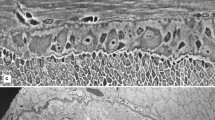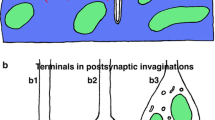Summary
Thin section and freeze-fracture replicas of the first optic neuropil (lamina ganglionaris) of the flyMusca were studied to determine the types, extent and location of membrane specializations between neurons. Five junctional types are found, exclusive of chemical synapses. These are gap, tight and septate junctions, close appositions between retinular (R) axons and capitate projections (in which an epithelial glial cell invaginates into an R axon). Junctional types and their cellular associations follow: gap junctions, between lamina (L) interneurons, L1–L2; tight junctions, between L1–L2; L3–L4; L4-epithelial glial cell; and R7–R8. Septate junctions, between L1–L2, L3–L4, L3-β, L4-β, α-β, and an unidentified fibre making septate junctions with L1 and L2. Close appositions are found between R axons in the distal portion of the optic cartridges of this neuropil prior to extensive R chemical synapses with L1, L2. These loci (seen in freeze-fracture replicas) have rhomboidal patches of hexagonally arrayed P face particles.
Intermembranous clefts between R axons are about 50 Å and are invariably electron lucent. These points of near contact between R terminals are probably the sites of low electrical resistance measured by Shaw (1979). Capitate projections are for the first time revealed in freeze fracture surfaces. Here epithelial glia send many, short, mushroom-shaped processes invaginating into R axons forming a tenacious structural bond. All four membrane leaflets (P and E faces of R axon and glial membrane) in the capitate projection possess particles in higher densities than in the surrounding nonspecialized regions. The known, general functions of each membrane specialization were correlated with the functional capacities of those lamina neurons possessing them in an effort to interpret better the integrative capacity of this neuropil. These data provide some fine structural bases for a putative ‘blood-brain’ barrier between lamina and haemolymph, between lamina and peripheral retina, and possibly between lamina and second optic neuropil.
Similar content being viewed by others
References
Arnett, D. W. (1972) Spatial and temporal integration properties of units in first optic ganglion of dipterans.Journal of Neurophysiology 35, 429–44.
Boschek, C. B. (1971) On the fine structure of the peripheral retina and lamina ganglionaris of the fly,Musca domestica.Zeitschrift für Zellforschung und mikroskopische Anatomie 118, 369–409.
Braitenberg, V. (1967) Patterns of projection in the visual system of the fly. I. Retina-lamina projections.Experimental Brain Research 3, 271–98.
Braitenberg, V. &Debbage, P. (1974) A regular net of reciprocal synapses of the visual system of the fly,Musca domestica.Journal of Comparative Physiology 90, 25–31.
Burkhardt, W. &Braitenberg, V. (1976) Some peculiar synaptic complexes in the first visual ganglion of the fly,Musca domestica.Cell and Tissue Research 173, 287–308.
Campos-Ortega, J. A. (1974) Autoradiographic localization of3H-γ-amino-butyric acid uptake in the lamina ganglionaris ofMusca andDrosophila.Zeitschrift für Zellforschung und mikroskopische Anatomie 147, 415–31.
Campos-Ortega, J. A. &Strausfeld, N. J. (1973) Synaptic connections of intrinsic cells and basket arborizations in the external plexiform layer of the fly's eye.Brain Research 59, 119–36.
Chi, C. (1976)Electron microscopy of the peripheral retina and first optic neuropile of the housefly, Musca domestica L. Ph.D. thesis, University of Wisconsin, Madison.
Chi, C. &Carlson, S. D. (1976a) Close apposition of photoreceptor cell axons in the housefly.Journal of Insect Physiology 22, 1153–7.
Chi, C. &Carlson, S. D. (1976b) High voltage electron microscopy of the neuropile of the housefly,Musca domestica.Cell and Tissue Research 167, 537–45.
Chi, C. &Carlson, S. D. (1980) Membrane specializations in the first optic neuropil of the houseflyMusca domestica L, II. Junctions between glial cells.Journal of Neurocytology 9, 451–69.
Chi, C., Carlson, S. D. &St. Marie, R. L. (1979) Membrane specializations in the peripheral retina of the houseflyMusca domestica L.Cell and Tissue Research 198, 501–20.
Claude, P. &Goodenough, D. A. (1973) Fracture faces of zonulae occludentes from ‘tight’ and ‘leaky’ epithelia.Journal of Cell Biology 38, 390–400.
Eley, S. &Shelton, P. M. (1976) Cell junction in the developing compound eye of the desert locustShistocerca gregaria.Journal of Embryology and Experimental Morphology 36, 409–23.
Feldman, J., Gilula, N. B. &Pitts, J. D. (1978) (editors)Intercellular Junctions and Synapses. New York: Halsted Press.
Flower, N. E. (1972) A new junctional structure in the epithelia of insects of the order Dictyoptera,Journal of Cell Science 17, 221–39.
Flower, N. E. (1977) Invertebrate gap junctions.Journal of Cell Science 25, 163–71.
Gemne, G. (1969) Axon membrane crystallites in insect photoreceptors. InNobel Symposium. II. Symmetry and Function of Biological Systems at the Macromolecular Level (edited byEngström, A. andStrandberg, B.), pp. 305–309. Stockholm: Almquist and Wiksells.
Gilula, N. B. (1978) Structure of intercellular junctions. InIntercellular Junctions and Synapses (edited byFeldman, J., Gilula, N. B. andPitts, J. E.), pp. 3–22. New York: Halsted Press.
Järvilehto, M. &Zettler, F. (1973) Electrophysiological-histological studies on some functional properties of visual cells and second order neurones of an insect retina.Zeitschrift für Zellforschung und mikroskopische Anatomie 136, 291–306.
Kirschfeld, K. (1967) Die Projektion der optischen Umwelt vonMusca.Experimental Brain Research 3, 248–70.
Kirschfeld, K. (1972) The visual system ofMusca: Studies on optics, structure and function. InInformation Processing in the Visual System of Arthropods (edited byWehner, R.), pp. 61–74. Berlin, Heidelberg, New York: Springer-Verlag.
Kirschfeld, K. &Franceschini, N. (1969) Ein Mechanismus zur Steuerung des Lichtflusses in den Rhabdomeren des Komplexauges vonMusca.Kybernetik 6, 13–22.
Lane, N. J. (1978) Intercellular junctions and cell contacts in invertebrates. InProceedings of the Ninth International Congress of Electron Microscopy (edited bySturgess, J. M.), Vol. III, pp. 673–691. Toronto: Microscopical Society of Canada.
Lane, N. J. (1979) Tight junctions in a fluid-transporting epithelium of an insect.Science 204, 91–3.
Lane, N. J., Skaer, H. Le, B. &Swales, L. S. (1977) Intercellular junctions in the central nervous systems of insects.Journal of Cell Science 26, 175–99.
Lane, N. J. &Swales, L. S. (1978a) Changes in the blood-brain barrier of the central nervous system in the blowfly during development, with special references to the formation and disaggregation of gap and tight junctions. I. Larval development.Developmental Biology 62, 389–414.
Lane, N. J. &Swales, L. S. (1978b) Changes in the blood-brain barrier of the central nervous system in the blowfly during development, with special references to the formation and disaggregation of gap and tight junctions. II. Pupal development and adult flies.Developmental Biology 62, 415–31.
Lane, N. J. &Swales, L. S. (1979) Intercellular junctions and the development of the blood brain barrier inManduca sexta.Brain Research 168, 227–45.
Maunsbach, A. B. &Jørgensen, P. L. (1974) Ultrastructure of highly purified preparations of (Na+ + K+)-ATPase from the outer medulla of the rabbit kidney. InProceedings of the Eighth International Congress of Electron Microscopy Vol. II, pp. 214–5. Canberra: Australian Academy of Sciences.
Mcnutt, N. &Weinstein, R. S. (1973) Membrane ultrastructure at mammalian intercellular junctions.Progress in Biophysics and Molecular Biology 26, 45–101.
Miller, R. F. &Dowling, J. E. (1970) Intracellular responses of the Müller (glial) cells of mud puppy retina: their relation tob wave of the electroretinogram.Journal of Neurophysiology 33, 323–41.
Mimura, K. (1976) Some spatial properties in the first optic ganglion of the fly.Journal of Comparative Physiology 105, 65–82.
Mimura, K. (1978) Electrophysiological evidence for interaction between retinula cells in the fleshfly.Journal of Comparative Physiology 125, 209–16.
Møllgård, K., Malinowska, D. H. &Saunders, N. (1976) Lack of correlation between tight junction morphology and permeability properties in developing choroid plexus.Nature 264, 293–4.
Nickel, E. &Scheck, G. (1978) Cell junctions in the compound eye of the worker honey bee. InProceedings of the Ninth International Congress of Electron Microscopy (edited bySturgess, J. M.), Vol. II, pp. 608–609. Toronto: Microscopical Society of Canada.
Noirot-Timothée, C., Smith, D. S., Cayre, M. L. &Noirot, C. (1978) Septate junctions in insects: comparison between intercellular and intramembranous structures.Tissue and Cell 10, 125–36.
Peracchia, C. (1974) Excitable membrane ultrastructure 1. Freeze fracture of crayfish axons.Journal of Cell Biology 61, 107–22.
Quick, D. C. &Johnson, R. G. (1977) Gap junctions in rhombic particle arrays in Planaria.Journal of Ultrastructure Research 60, 348–61.
Ribi, W. A. (1978) Gap junctions coupling photoreceptor axons in the first optic ganglion of the fly.Cell and Tissue Research 195, 299–308.
Satir, P. &Gilula, N. B. (1973) The fine structure of membranes and intercellular communication in insects.Annual Review of Entomology 18, 143–66.
Scholes, J. (1969) The electrical responses of the retinal receptors and the lamina in the visual system of the flyMusca.Kybernetik 6, 149–62.
Shaw, S. R. (1977) Restricted diffusion and extracellular space in the insect retina.Journal of Comparative Physiology 113, 257–82.
Shaw, S. R. (1978) The extracellular space and blood-eye barrier in an insect retina: An ultrastructural study.Cell and Tissue Research 188, 35–61.
Shaw, S. R. (1979) Photoreceptor interaction of the lamina synapse of the fly's compound eye. InAssociation for Research in Vision and Ophthalmology, Spring Meeting, Sarasota, Florida, abstracts, p. 6.
Skaer, H. Le, B. &Lane, N. J. (1974) Junctional complexes, perineural and glia-axonal relationships and the ensheathing structures of the insect nervous system; A comparative study using conventional and freeze-cleaving techniques.Tissue and Cell 6, 695–718.
Skaer, H. Le, B., Berridge, M. J. &Lee, W. M. (1975) A freeze fracture study pf adultCalliphora salivary glands.Tissue and Cell 3, 261–81.
Sohal, R. S. &Sharma, S. P. (1973) Membrane junctions between neurones in the brain of the houseflyMusca domestica. InProceedings of the 31st Annual Meeting of Electron Microscope Societies of America, pp. 662–3.
Staehelin, L. A. (1974) Structure and function of intercellular junctions.International Review of Cytology 39, 191–283.
Strausfeld, N. J. (1970) Golgi studies on insects (Part II. The optic lobes of Diptera).Philosophical Transactions of the Royal Society, Series B 258, 135–223.
Strausfeld, N. J. (1971) The organization of the insect visual system (light microscopy) I. Projections and arrangements of neurons in the lamina ganglionaris of Diptera.Zeitschrift für Zellforschung und mikroskopische Anatomie 121, 377–441.
Strausfeld, N. J. (1976)Atlas of an Insect Brain. Berlin, Heidelberg, New York: Springer-Verlag.
Strausfeld, N. J. &Campos-Ortega, J. A. (1972) Some interrelationships between the first and second synaptic regions of the fly's (Musca domestica L.) visual system. InInformation Processing in the Visual System of Arthropods (edited byWehner, R.), pp. 23–30. Berlin, Heidelberg, New York: Springer-Verlag.
Strausfeld, N. J. &Campos-Ortega, J. A. (1973a) L3, the 3rd second order neuron of the 1st visual ganglion in the neural superposition eye.Zeitschrift für Zellforschung und mikroskopische Anatomie 139, 397–403.
Strausfeld, N. J. &Campos-Ortega, J. A. (1973b) The L4 monopolar neurone: a substrate for lateral interaction in the visual system of the flyMusca domestica (L).Brain Research 59, 97–117.
Strausfeld, N. J. &Campos-Ortega, J. A. (1977) Vision in insects: Pathways possibly underlying neural adaptation and lateral inhibition.Science 195, 894–97.
Treherne, J. E. (1974) The environment and function of insect nerve cells. InInsect Neurobiology (edited byTreherne, J. E.), pp. 187–244. New York: American-Elsevier.
Trujillo-Cenoz, O. (1965) Some aspects of the structural organization of the intermediate retina of Dipterans.Journal of Ultrastructure Research 13, 1–33.
Trujillo-Cenoz, O. &Melamed, J. (1966) Compound eye of dipterans —Anatomical basis for integration — an electron microscope study.Journal of Ultrastructure Research 16, 395–8.
Vigier, P. (1907) Sur les terminations photoreceptrices dan les yeux, composes de Muscides,Comptes rendus hebdomadaire des Séances de l'Academie des sciences 145, 532–6.
Zettler, F. &Järvilehto, M. (1971) Decrement-free conduction of graded potentials along the axon of a monopolar neuron.Zeitschrift für vergleichende Physiologie 75, 402–21.
Zettler, F. &JÄrvilehto, M. (1972) Lateral inhibition in an insect eye.Zeitschrift für vergleichende Physiologie 76, 233–44.
Zettler, F. &Järvilehto, M. (1973) Active and passive axonal propagation of non-spike signals in the retina ofCalliphora.Journal of Comparative Physiology 85, 89–104.
Author information
Authors and Affiliations
Rights and permissions
About this article
Cite this article
Chi, C., Carlson, S.D. Membrane specializations in the first optic neuropil of the housefly,Musca domestica L. I. Junctions between neurons. J Neurocytol 9, 429–449 (1980). https://doi.org/10.1007/BF01204835
Received:
Revised:
Accepted:
Issue Date:
DOI: https://doi.org/10.1007/BF01204835




